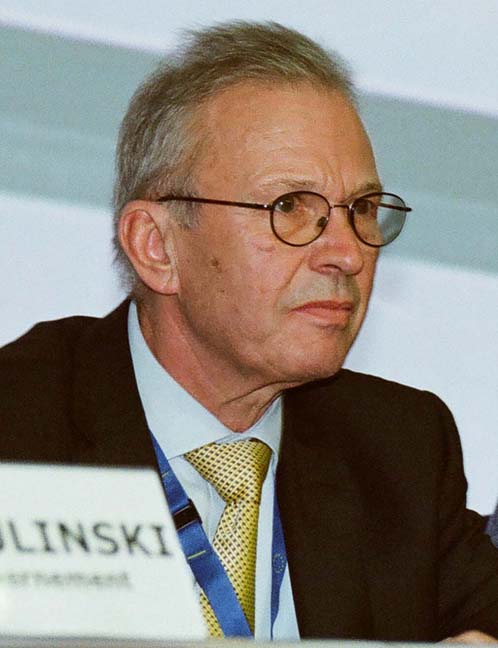Manuel Del Castillo – Broadcom pushing GNSS chipset boundaries
High-tech standout Broadcom has sold over one billion GNSS chipsets worldwide, leveraging all major global satellite navigation constellations and the full range of GNSS features, including Galileo’s dual-frequency and innovative BOC modulation capabilities.
Broadcom is doing things that no other company in the world is doing. Positioned right at the leading edge of GNSS-for smartphone technologies, the company boasts an extensive portfolio of standalone GNSS receiver chips and combination GNSS receiver and sensor-hub, or location-hub, chips.
Already an industry leader in multiconstellation GNSS technologies, present in the latest, top-of-the-line handsets, Broadcom positively threw down the gauntlet last year with the inauguration of its new BCM47755 chipset, the first dual-frequency GNSS chipset for smartphones. The unveiling, which came in the fall of 2017, led European GNSS Agency (GSA) Director Carlo des Dorides to suggest we might see a fully functional dual-frequency smartphone as early as summer 2018.
Obviously Multi-Constellation
Broadcom has always been a firm believer in the cumulative value of each additional GNSS constellation. Speaking from his office in Madrid, Broadcom’s Associate Director for GNSS Product Marketing Manuel del Castillo told us, “We initially supported GPS and then progressively added all of the other major GNSS constellations – GLONASS, BeiDou and Galileo.
“We treat the different GNSS signals in an equivalent way, in terms of acquisition and tracking, and interchangeability in subsequent fixes. Our motivation has always been accuracy and yield improvements in challenging urban environments, where our customers have constantly pushed us to keep improving.”
The first Broadcom multi-constellation chip, adding GLONASS to GPS, came in 2011. “After that, in 2013, we added BeiDou,” del Castillo said. “And in 2014, two years before Galileo Initial Services were announced, Broadcom added Galileo.
“Our Galileo chip features a multipurpose, sensor-hub and sensor-fusion software for use in smartphones and tablets, as well as ‘system-on-chip’ architecture, so we can meet the challenge of always-on location with very low power. And of course our users benefit not only from the additional Galileo satellites, but from the new BOC modulation, which itself improves accuracy.”
In each case, del Castillo said, whether it was adding GLONASS, BeiDou or Galileo, similar processes were involved, including understanding the ICD, discussing implementation and testing initial prototypes, developing the B0 revision and carrying out receiver tests.
“In the case of Galileo, however,” he said, “there is a lot more support and clarity compared to previous constellations, in particular BeiDou. And Galileo is easier in terms of the RF part than GLONASS or BeiDou. On the other hand, Galileo’s baseband is more complex due to the longer codes, secondary codes and BOC modulation.”
Dual Frequency at Last
Last year, Broadcom launched the chip that changed everything. “The BCM47755 in includes support for dual frequency in both GPS L1 and L5, and Galileo E1 and E5,” said del Castillo.
Until now, mobile positioning and navigation devices have been powered by single-frequency GNSS receivers. The expanded availability of L1/E1 and L5/E5 frequencies, thanks especially to Europe’s Galileo constellation, now means reduced multipath and ionospheric interference, improving positioning in urban and other environments.
“We are working with a number of handset vendors, Samsung in particular, to bring multi-constellation and multi-frequency capabilities to your next smartphone,” said del Castillo. “The BCM47755 provides a high level of accuracy with minimal power consumption and footprint, and is capable of enabling an entirely new set of high-precision LBS applications.” These include lane-level vehicle navigation, advanced gaming apps, mobile augmented reality, car-hailing applications, driving assistance for cars, drone guidance, and many others that have yet to be imagined.
Del Castillo said the decision to go dual-frequency was an easy one to make. “Once we were sure that the cost increase was going to be tolerable and the technical benefits would be far greater than the added cost, we forged ahead quickly. Of course we were moving into unexplored territory for a mass-market chip. The development process was extensive and it involved a substantial chip revision.
“A major challenge was always going to be the ten-fold increase in complexity of L5/E5 signals, and the fine-tuning of the internal phase delays between L1/E1 signals and L5/ E5 signals. Also, there was the need for additional memory and computational resources, while reducing power consumption. And we had to do all of this with a minimal cost impact for our customers.”
“Bringing in Galileo and, most importantly, implementing the dualfrequency support has absolutely paid off,” del Castillo said. “The benefits for our customers start, of course, with the performance improvement, delivering reliable sub-meter accuracy even in difficult environments. But for Broadcom itself, supporting Galileo in E1 and in E5 means we are now clear leaders in the innovation race, and we are benefiting from joint actions with the GSA and working in partnership with ESA.”
Not Standing Still
Competitors beware; the gang at Broadcom shows no signs of resting on their laurels. In another example of innovative thinking, the company has recently partnered with Google to host some location-based applications within its GNSS chipsets. Activity recognition is one such application that uses smartphone sensors to determine what the user is doing, i.e. walking, biking, driving, etc. The application can run on the smartphone’s own applications processor, which uses quite a bit of power, or, now, it can be pushed down to a low-power processor in an onboard Broadcom GNSS chip.
Del Castillo said Broadcom is intent on staying smart, harnessing its multiconstellation and multi-frequency GNSS technologies to maintain and increase its advantage over all competitors. “We see further refinements coming in our E5 implementation, ultimately allowing us to deliver even higher accuracy for newer and even more exciting applications. As long as we keep moving the innovation bar higher and higher, we believe we can stay a step ahead of the competition, and the ultimate winner will be the GNSS user.”




